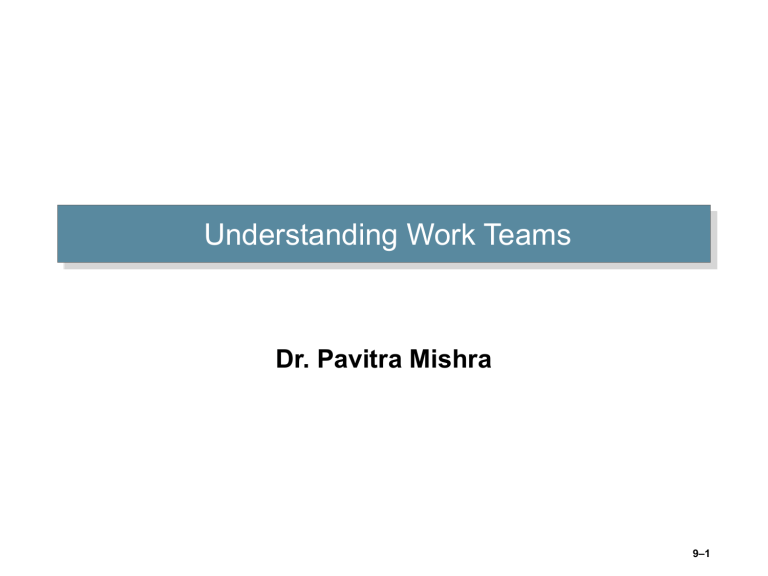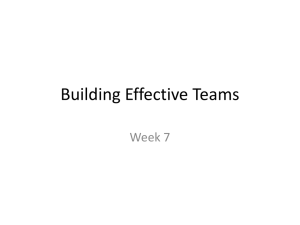
Understanding Work Teams Dr. Pavitra Mishra 9–1 Why Have Teams Become So Popular Teams typically outperform individuals. Teams use employee talents better. Teams are more flexible and responsive to changes in the environment. Teams facilitate employee involvement. Teams are an effective way to democratize and organization and increase motivation. 9–2 Team Versus Group: What’s the Difference Work Group A group that interacts primarily to share information and to make decisions to help each group member perform within his or her area of responsibility. Work Team A group whose individual efforts result in a performance that is greater than the sum of the individual inputs. 9–3 Beware: Teams Aren’t Always the Answer Three tests to see if a team fits the situation: – Is the work complex and is there a need for different perspectives? – Does the work create a common purpose or set of goals for the group that is larger than the aggregate of the goals for individuals? – Are members of the group involved in interdependent tasks? 9–4 Types of Teams Problem-Solving Teams Groups of 5 to 12 employees from the same department who meet for a few hours each week to discuss ways of improving quality, efficiency, and the work environment. Self-Managed Work Teams Groups of 10 to 15 people who take on the responsibilities of their former supervisors. 9–5 Types of Teams (cont’d) Cross-Functional Teams Employees from about the same hierarchical level, but from different work areas, who come together to accomplish a task. • Task forces • Committees 9–6 Types of Teams (cont’d) Virtual Teams Teams that use computer technology to tie together physically dispersed members in order to achieve a common goal. Team Characteristics 1. The absence of paraverbal and nonverbal cues 2. A limited social context 3. The ability to overcome time and space constraints 9–7 Multi-team System A collection of two or more interdependent teams that share a subordinate goal; a team of teams 9–8 Team Development Stages: Tuckman & Jensen 9–9 Roles Role: A set of expected behavior patterns attributed to someone occupying a given position in a social unit Role expectation: How others believe person should act in a given situation Role perception: An individual’s view how s/he may act in a given situation Role conflict: A situation in which an individual is confronted by divergent role expectations 9–10 Team Roles Linker: Coordinates and integrates Creator: Initiate creative ideas Promoter: Champions ideas after they are initiated Assessor: Offers insightful analysis of options Organizer: Provides Structure Producer: Provides direction and follow-through Controller: Examine details and enforces rules Maintainer: Fights external battles Adviser: Encourages the search for more information 9–11 Belbin’s 9 Team Roles 9–12 Belbin’s 9 Team Roles Thinking-Oriented Roles – Plant: Innovator and Ideas – Monitor Evaluator: Separate good ideas from bad – Specialist: skills in specialist job Action Oriented Roles – Shaper: Challenge norms, push team, takes lead – Implementor: Executor of plans – Completer/Finisher: Complete the fine details People-Oriented Roles – Coordinator: Natural team leader – Team Worker: Ensures team is working well together. Weakness: Diplomats – Resource Investigator: Finds external resources 9–13 Team Effectiveness Model Context – – – – Adequate Resources Effective Leadership Trust Performance and Reward System Composition – – – – – – – Abilities of Members Personality Allocating Roles Diversity Cultural differences Size of team Member preferences 9–14 Process – – – – – – – – Common purpose Specific Goals Team Efficacy Team Identity Team Cohesion Conflict levels Mental Models Social Loafing 9–15 Team Effectiveness Model 9–16 Key Terms Social Loafing: The tendency for individuals to expend less effort when working collectively than when working individually Group cohesiveness: The degree to which group members are attracted to each other and are motivated to stay together Group think: A phenomenon in which the norm for consensus overrides the realistic appraisal of alternative course of action Group shift: A change between group’s decision and individual’s decision that a member within the group would make; the shift can be either towards conservatism or risky shift. 9–17 Team Charter Context: Why team exists Mission and Objective: Short clean statement of what team needs to achieve and deliver Composition: Design of the team Authority and empowerment: Matters in which team needs to take permission and vice-versa, team boundaries to avoid any conflict with other teams Resources and support available: Money, time, people, training, equipment, coaching etc. Operations: Basic line of functioning, acceptable behaviors, common rules, ethics Stakeholders: External and Internal 9–18 Turning Individuals Into Team Players The Challenges – Overcoming individual resistance to team membership. – Countering the influence of individualistic cultures. – Introducing teams in an organization that has historically valued individual achievement. Shaping Team Players – Selecting employees who can fulfill their team roles. – Training employees to become team players. – Reworking the reward system to encourage cooperative efforts while continuing to recognize individual contributions. 9–19 Teams and Quality Management Team Effectiveness and Quality Management Requires That Teams: 1. Are small enough to be efficient and effective. 2. Are properly trained in required skills. 3. Allocated enough time to work on problems. 4. Are given authority to resolve problems and take corrective action. 5. Have a designated “champion” to call on when needed. 9–20 John Heron’s Six Categories of Intervention Prescriptive Informative Confronting Cathartic Catalytic Supportive 9–21 …Continued 9–22 Google: Team Effectiveness Video https://www.youtube.com/watch?v=hHIikHJV9fI 9–23



